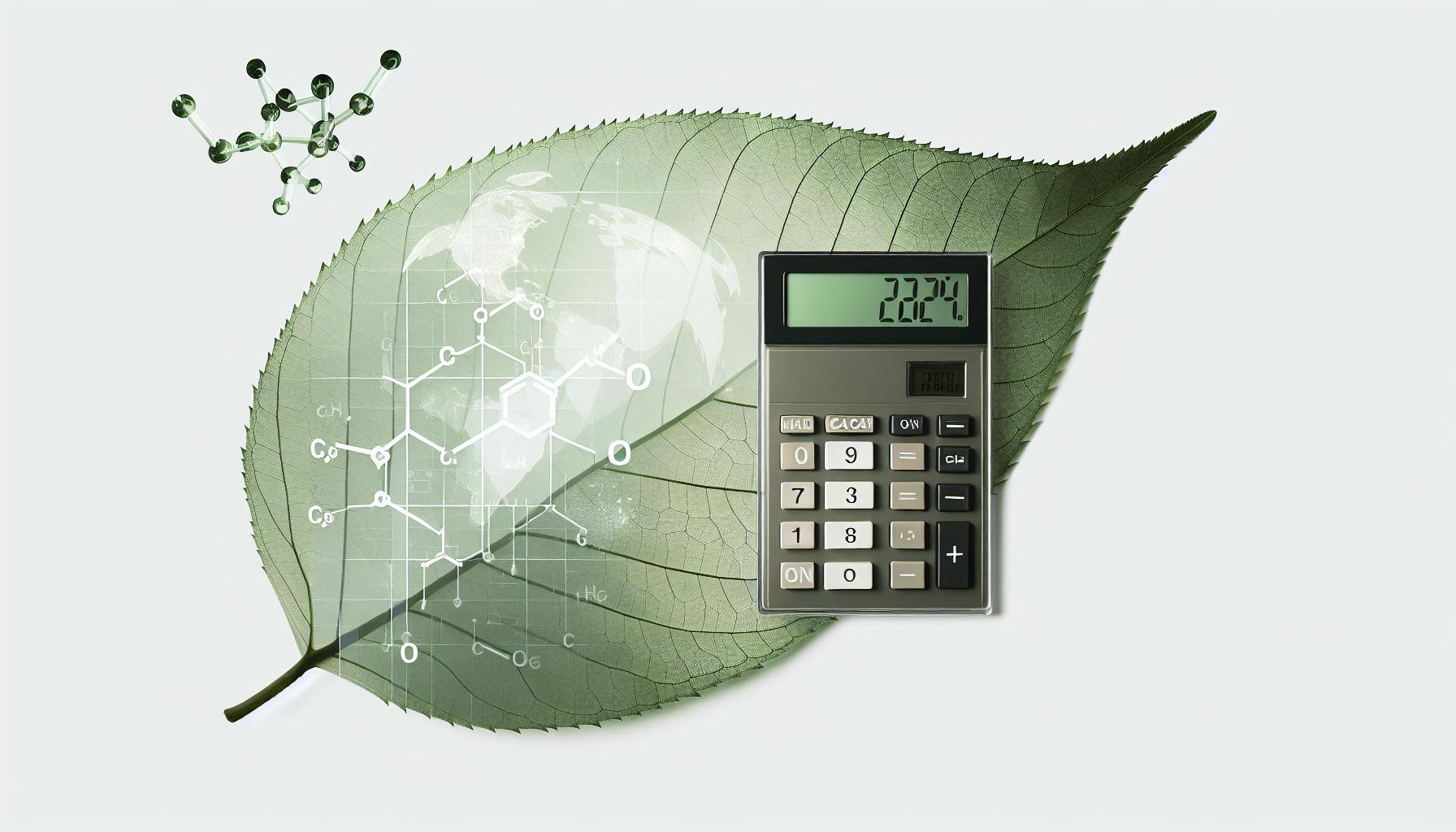Carbon labels on food products provide consumers with transparent information about the product's carbon footprint, enabling them to make informed, environmentally-conscious purchasing decisions. These labels work similarly to nutritional labels, displaying the greenhouse gas emissions associated with a product throughout its lifecycle.
Key Benefits of Carbon Labels
-
Empower consumers to reduce their carbon footprint
-
Drive businesses to adopt sustainable practices
-
Promote transparency and accountability in the food industry
Types of Carbon Labels
| Label Type | Description |
|---|---|
| Total Emissions | Displays the total carbon emissions associated with the product's lifecycle |
| Carbon Reduction | Indicates the product's carbon emissions have been reduced by a certain percentage |
| Carbon Neutral | Indicates the company has offset the product's emissions through renewable energy or reforestation |
| Comparative | Compares the product's carbon footprint to industry averages or similar products |
Consumer Impact
-
Studies show carbon labels can shift consumer behaviour towards more sustainable choices
-
Consumers are willing to pay a premium for products with transparent carbon labelling
Business Benefits
-
Track sustainability progress and build consumer trust
-
Identify areas for emission reductions and cost savings
-
Attract skilled employees committed to sustainability
Challenges and Future
-
Standardising carbon labels across companies and regions
-
Educating consumers on the significance of carbon labels
-
Preventing misleading or greenwashing claims
-
Growing adoption and regulations for carbon labelling schemes
-
Combining carbon labels with other eco-labels for a comprehensive environmental impact picture
Measuring Carbon Footprints
Measuring carbon footprints is a crucial step in understanding the environmental impact of food products. This process involves calculating the greenhouse gas emissions associated with a product, from production to consumption.
Lifecycle Carbon Footprint Analysis
A lifecycle carbon footprint analysis is a comprehensive approach to measuring the carbon footprint of a product. This analysis considers all stages of a product's life cycle, including:
-
Raw material extraction
-
Transportation
-
Manufacturing
-
Packaging
-
Distribution
-
Disposal
By analysing each stage, manufacturers can identify areas where they can reduce their carbon footprint.
Benefits of Lifecycle Carbon Footprint Analysis
-
Provides a detailed understanding of a product's carbon footprint
-
Enables manufacturers to make informed decisions about reducing their emissions
-
Helps manufacturers identify opportunities for cost savings
-
Improves brand reputation
-
Complies with emerging regulations
Third-Party Verification
Third-party verification is an essential step in ensuring the accuracy and credibility of carbon labels. Third-party organisations, such as CarbonCloud, verify the climate footprints of products by:
-
Appointing a verifier who meets specific requirements
-
Reviewing the models created by the manufacturer on the platform
-
Asking critical questions to ensure the accuracy of the climate footprint quantification
Benefits of Third-Party Verification
-
Provides an added layer of transparency and accountability
-
Gives consumers confidence in the accuracy of the carbon labels
-
Helps manufacturers ensure that their carbon labels are accurate and trustworthy
-
Builds consumer trust and credibility
sbb-itb-c2a0016
Types of Carbon Labels
Carbon labels come in different forms, each providing unique information about a product's environmental impact. Understanding these different types of labels is essential for consumers and businesses alike.
Total Emissions Labels
Total emissions labels display the total carbon emissions associated with a product throughout its lifecycle. This includes emissions from production, transportation, storage, use, and disposal.
| Label Example | Description |
|---|---|
| 1.2 kg CO2e per serving | Indicates the total carbon emissions associated with producing, transporting, storing, using, and disposing of one serving of the product |
Carbon Reduction and Neutral Claims
Carbon reduction and neutral claims indicate that a product's carbon emissions have been reduced or offset.
| Label Example | Description |
|---|---|
| 20% reduced carbon footprint | Indicates that the product's carbon emissions have been reduced by 20% compared to the previous year |
| Carbon neutral | Indicates that the company has offset the emissions associated with the product's production by investing in renewable energy projects or reforestation efforts |
Comparative Carbon Labels
Comparative carbon labels provide consumers with a benchmark by comparing the product's carbon footprint to the industry average or similar products.
| Label Example | Description |
|---|---|
| 30% lower carbon footprint than the average product in this category | Indicates that the product has a significantly lower carbon footprint than similar products on the market |
By understanding these different types of carbon labels, consumers can make more informed purchasing decisions, and businesses can effectively communicate their commitment to sustainability.
Consumer Impact
Carbon labels have a significant influence on consumer behaviour, affecting their purchasing decisions and willingness to pay for sustainable products.
Buying Choices
Studies have shown that carbon labels can shift consumer behaviour towards more sustainable choices. For example:
| Study Finding | Description |
|---|---|
| 25% lower climate impact | Participants chose products with lower carbon footprints when presented with carbon footprint information |
| 13.5% emissions drop | Consumers chose products with lower carbon footprints when climate-friendly options were the default |
This suggests that carbon labelling can effectively nudge consumers towards more environmentally friendly options.
Paying for Sustainability
Consumers are increasingly willing to pay a premium for products with transparent carbon labelling. A survey found that:
| Country | Support for Carbon Labels |
|---|---|
| UK | 66% |
| US | 66% |
| Germany | 66% |
| Other European countries | 66% |
Moreover, research has shown that consumers are willing to pay up to 10% more for products with clear carbon labelling. This willingness to pay a premium for sustainable products can incentivise businesses to invest in reducing their carbon footprint and adopting environmentally friendly practices.
By providing consumers with clear and transparent information about the environmental impact of products, carbon labels can empower them to make informed choices and drive demand for sustainable products. As consumers become more environmentally conscious, businesses that adopt sustainable practices and transparent carbon labelling are likely to benefit from increased customer loyalty and revenue.
Business Benefits
Tracking Sustainability and Trust
Carbon labels help businesses track their sustainability progress and build trust with consumers. By providing transparent and accurate information about their products' carbon footprint, companies can demonstrate their commitment to reducing emissions and mitigating climate change. This leads to increased customer loyalty and brand value.
| Study Finding | Description |
|---|---|
| 79% of customers | Changing preferences based on products' environmental or social impact |
| 77% of companies | Improved relationships with customers by marketing themselves as more sustainable |
Reducing Emissions
Measuring and labelling carbon footprints also helps businesses identify areas for emission reductions. By optimising logistics, sourcing materials from sustainable suppliers, and investing in renewable energy, companies can reduce their carbon footprint and costs. This leads to a more sustainable future and improved operational efficiency.
Moreover, carbon labelling can attract skilled and committed employees who want to work for companies that prioritise sustainability and social responsibility. This gives businesses a competitive edge in the labour market.
Challenges and Issues
The adoption of carbon labels on food products is not without its challenges. Several obstacles need to be addressed to ensure the effective implementation and standardisation of carbon labels.
Standardizing Labels
One of the significant challenges is the lack of a unified standard for carbon labels. Different companies and countries are developing their own carbon labelling systems, leading to confusion among consumers. A standardised framework is essential to ensure that carbon labels are consistent, reliable, and comparable across products and regions.
| Challenge | Description |
|---|---|
| Lack of standardisation | Different companies and countries have their own carbon labelling systems, causing confusion among consumers |
| Inconsistent labels | Labels may not be consistent, reliable, or comparable across products and regions |
Consumer Education
Another challenge is ensuring that consumers are well-informed about what carbon labels mean and how to use them for making decisions. Many consumers may not fully understand the concept of carbon footprint, making it essential to educate them about the significance of carbon labels.
| Challenge | Description |
|---|---|
| Lack of consumer understanding | Consumers may not fully understand the concept of carbon footprint and how to use carbon labels |
| Need for education | Educating consumers about the significance of carbon labels is essential for making informed decisions |
Preventing Misleading Claims
There is also a concern that some companies may use carbon labels as a marketing tactic without making substantial environmental improvements. This can lead to greenwashing, where companies mislead consumers about their environmental credentials.
| Challenge | Description |
|---|---|
| Misleading claims | Companies may use carbon labels as a marketing tactic without making substantial environmental improvements |
| Greenwashing | Companies may mislead consumers about their environmental credentials |
By addressing these challenges, we can ensure that carbon labels become a valuable tool for consumers, businesses, and the environment.
Future of Carbon Labeling
As consumers become more environmentally conscious, the demand for carbon labels on food products is expected to grow. Governments and companies are responding to this trend by implementing carbon labelling schemes and regulations.
Adoption and Regulations
More countries are adopting carbon labelling schemes. Denmark has pledged to spend $1.3 million to develop food carbon labelling proposals by the end of 2024. Other countries, such as Japan, South Korea, and Switzerland, have also implemented carbon labelling schemes.
| Country | Action |
|---|---|
| Denmark | Developing food carbon labelling proposals by 2024 |
| Japan | Implemented carbon labelling scheme |
| South Korea | Implemented carbon labelling scheme |
| Switzerland | Implemented carbon labelling scheme |
Global Standards
A unified global carbon labelling system is needed to ensure consistency and comparability across products and regions. Initiatives are underway to create standardised global carbon labelling systems.
Combining with Other Eco-Labels
Carbon labels can be combined with other eco-labelling efforts to provide a more comprehensive picture of a product's environmental impact. This could include labels that indicate a product's water footprint, biodiversity impact, or waste generation.
In conclusion, the future of carbon labelling looks promising, with growing adoption and regulations, standardised global systems, and the potential to combine with other eco-labels. As consumers become more environmentally conscious, carbon labels will play a critical role in helping them make sustainable choices and driving companies to reduce their environmental impact.
Conclusion
In conclusion, carbon labels on food have the power to change the way we make environmentally conscious choices. By providing clear and accurate information about the carbon footprint of food products, carbon labels can empower consumers to make informed decisions that align with their values.
The Benefits of Carbon Labels
Carbon labels can bring several benefits, including:
-
Increased customer loyalty and brand value
-
Driving businesses to adopt more sustainable practices
-
Promoting a culture of transparency and accountability
The Future of Carbon Labeling
As consumers become more environmentally conscious, the demand for carbon labels on food products is expected to grow. Governments and companies are responding to this trend by implementing carbon labelling schemes and regulations.
Making a Difference
Ultimately, carbon labels on food have the potential to make a significant impact on reducing greenhouse gas emissions and promoting sustainable food systems. By supporting carbon labelling initiatives and making environmentally conscious choices, we can work together to create a more sustainable future.
FAQs
What is carbon labelling of food?
Carbon labelling on food products provides consumers with information about the product's carbon footprint. This helps consumers make informed choices about the environmental impact of their food purchases.
What to consider when creating a carbon labelling policy?
When creating a carbon labelling policy, consider the following:
| Step | Description |
|---|---|
| Gather data | Collect accurate data on the product's carbon footprint through lifecycle assessment |
| Design the label | Create a clear and concise label that effectively communicates the carbon footprint to consumers |
| Ensure transparency | Ensure transparency and accountability in the labelling process |
| Consider consumer behaviour | Think about how the label may impact consumer behavior and purchasing decisions |
| Monitor and improve | Develop a strategy for ongoing monitoring and improvement of the carbon labelling policy |


